Mining Profitability in Australia: Production Costs Impact
VerifiedAdded on 2023/06/06
|28
|4741
|356
Report
AI Summary
This report examines the impact of production costs on the profitability of the Australian mining sector. The study investigates the relationship between operational costs and profit margins using data from 1996-2015. It analyzes key cost factors, including mining equipment, wages, and energy, and employs correlation analysis to determine the strength and direction of their influence on profitability. The report addresses research questions on how production costs relate to profitability across different mining sectors and if there are any differences in production costs over the specified period. The findings reveal a positive correlation between production costs and industry profitability. The methodology includes data collection from the Australian Bureau of Statistics, data preparation, and the use of Pearson correlation to test hypotheses. The report also includes a literature review that covers mining's role in the Australian GDP, revenue, profit, and cost relationships, and capital-to-output ratios. The study concludes by highlighting the implications of the findings and discussing potential areas for future research.
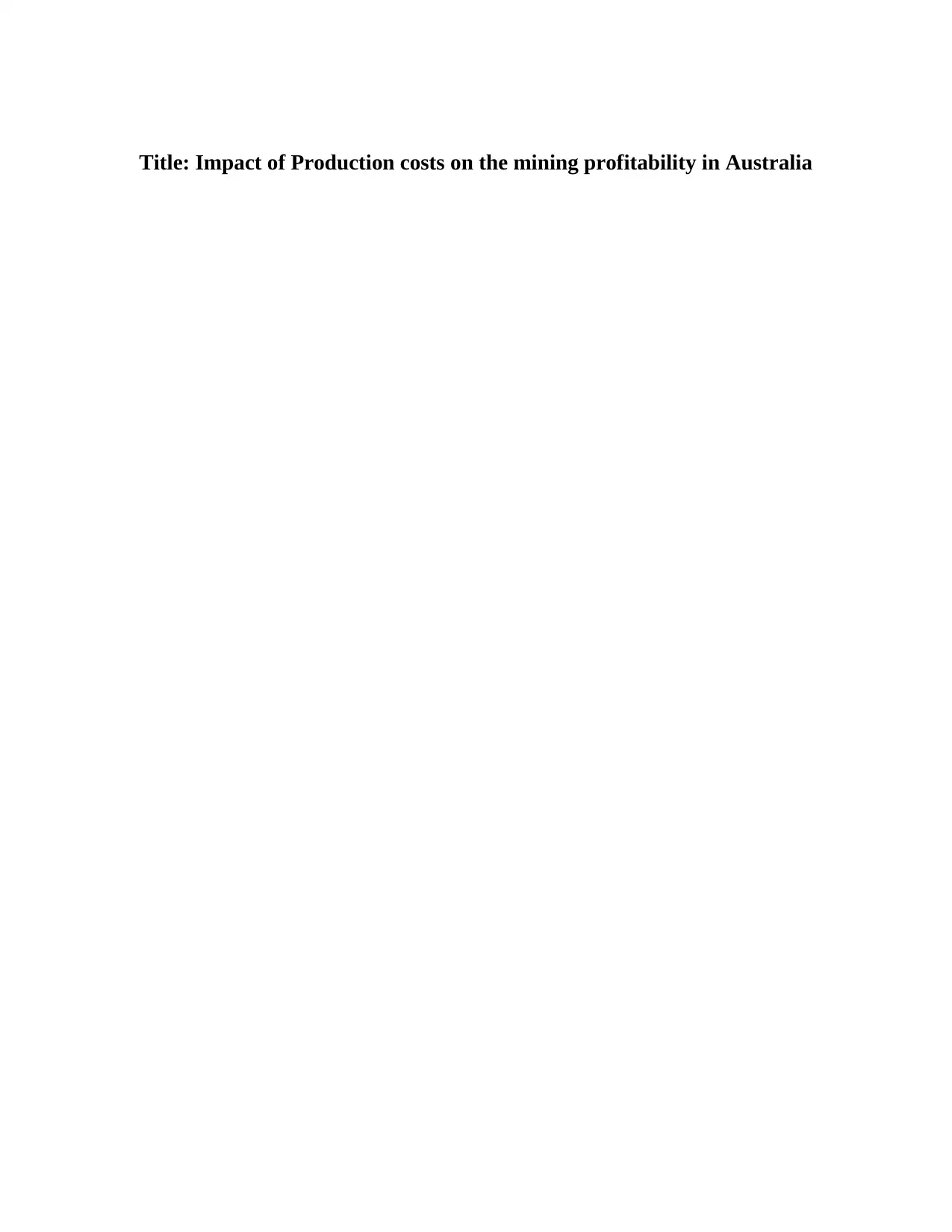
Title: Impact of Production costs on the mining profitability in Australia
Paraphrase This Document
Need a fresh take? Get an instant paraphrase of this document with our AI Paraphraser
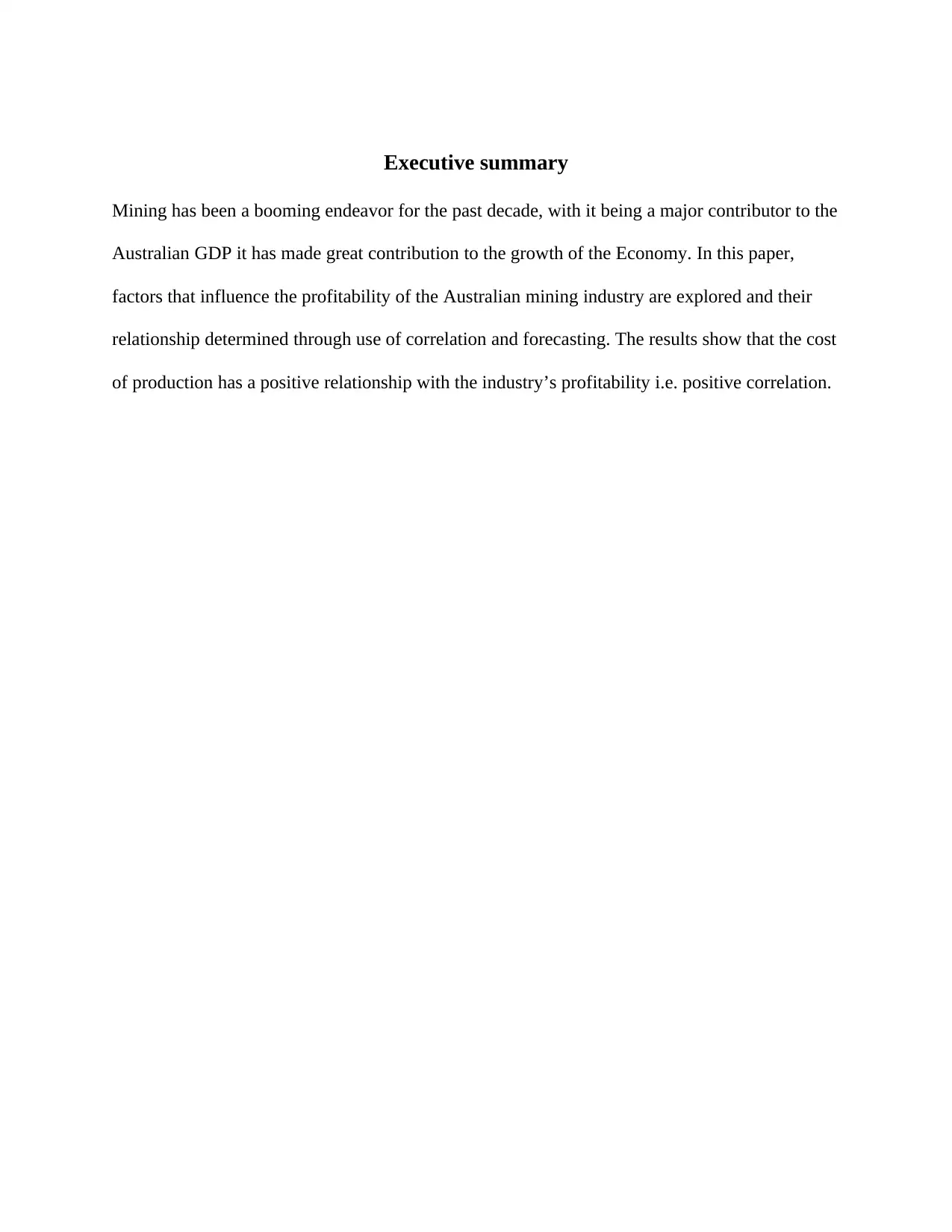
Executive summary
Mining has been a booming endeavor for the past decade, with it being a major contributor to the
Australian GDP it has made great contribution to the growth of the Economy. In this paper,
factors that influence the profitability of the Australian mining industry are explored and their
relationship determined through use of correlation and forecasting. The results show that the cost
of production has a positive relationship with the industry’s profitability i.e. positive correlation.
Mining has been a booming endeavor for the past decade, with it being a major contributor to the
Australian GDP it has made great contribution to the growth of the Economy. In this paper,
factors that influence the profitability of the Australian mining industry are explored and their
relationship determined through use of correlation and forecasting. The results show that the cost
of production has a positive relationship with the industry’s profitability i.e. positive correlation.
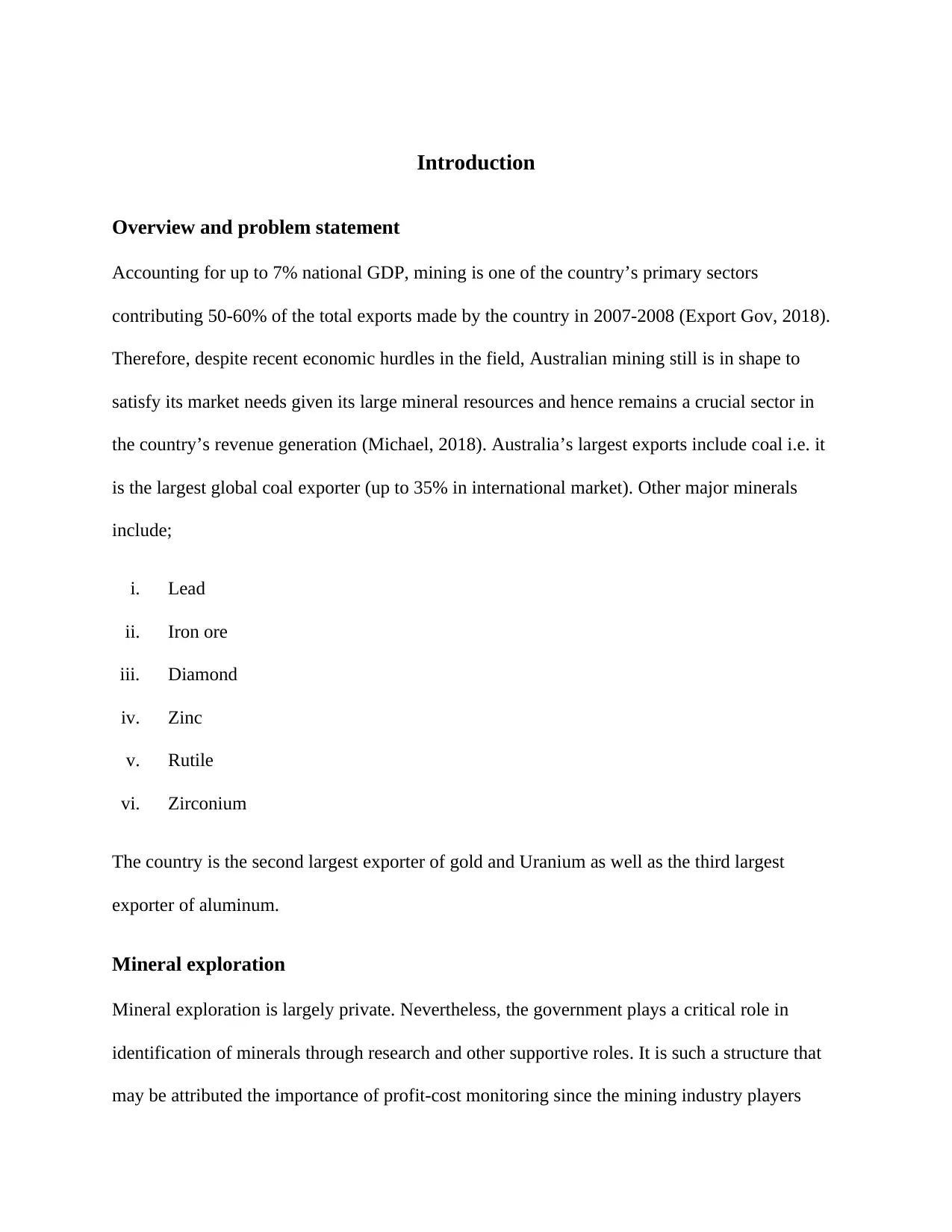
Introduction
Overview and problem statement
Accounting for up to 7% national GDP, mining is one of the country’s primary sectors
contributing 50-60% of the total exports made by the country in 2007-2008 (Export Gov, 2018).
Therefore, despite recent economic hurdles in the field, Australian mining still is in shape to
satisfy its market needs given its large mineral resources and hence remains a crucial sector in
the country’s revenue generation (Michael, 2018). Australia’s largest exports include coal i.e. it
is the largest global coal exporter (up to 35% in international market). Other major minerals
include;
i. Lead
ii. Iron ore
iii. Diamond
iv. Zinc
v. Rutile
vi. Zirconium
The country is the second largest exporter of gold and Uranium as well as the third largest
exporter of aluminum.
Mineral exploration
Mineral exploration is largely private. Nevertheless, the government plays a critical role in
identification of minerals through research and other supportive roles. It is such a structure that
may be attributed the importance of profit-cost monitoring since the mining industry players
Overview and problem statement
Accounting for up to 7% national GDP, mining is one of the country’s primary sectors
contributing 50-60% of the total exports made by the country in 2007-2008 (Export Gov, 2018).
Therefore, despite recent economic hurdles in the field, Australian mining still is in shape to
satisfy its market needs given its large mineral resources and hence remains a crucial sector in
the country’s revenue generation (Michael, 2018). Australia’s largest exports include coal i.e. it
is the largest global coal exporter (up to 35% in international market). Other major minerals
include;
i. Lead
ii. Iron ore
iii. Diamond
iv. Zinc
v. Rutile
vi. Zirconium
The country is the second largest exporter of gold and Uranium as well as the third largest
exporter of aluminum.
Mineral exploration
Mineral exploration is largely private. Nevertheless, the government plays a critical role in
identification of minerals through research and other supportive roles. It is such a structure that
may be attributed the importance of profit-cost monitoring since the mining industry players
⊘ This is a preview!⊘
Do you want full access?
Subscribe today to unlock all pages.

Trusted by 1+ million students worldwide
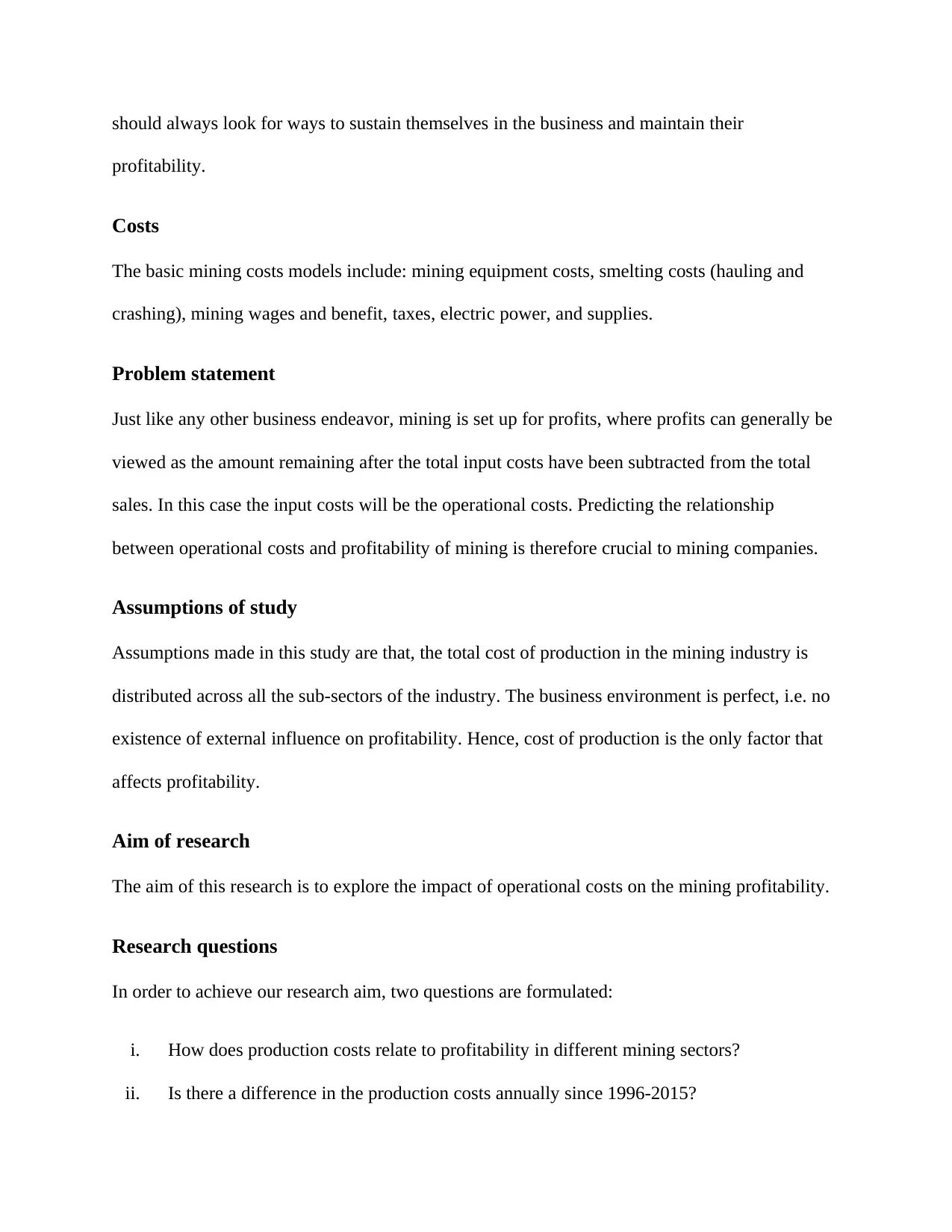
should always look for ways to sustain themselves in the business and maintain their
profitability.
Costs
The basic mining costs models include: mining equipment costs, smelting costs (hauling and
crashing), mining wages and benefit, taxes, electric power, and supplies.
Problem statement
Just like any other business endeavor, mining is set up for profits, where profits can generally be
viewed as the amount remaining after the total input costs have been subtracted from the total
sales. In this case the input costs will be the operational costs. Predicting the relationship
between operational costs and profitability of mining is therefore crucial to mining companies.
Assumptions of study
Assumptions made in this study are that, the total cost of production in the mining industry is
distributed across all the sub-sectors of the industry. The business environment is perfect, i.e. no
existence of external influence on profitability. Hence, cost of production is the only factor that
affects profitability.
Aim of research
The aim of this research is to explore the impact of operational costs on the mining profitability.
Research questions
In order to achieve our research aim, two questions are formulated:
i. How does production costs relate to profitability in different mining sectors?
ii. Is there a difference in the production costs annually since 1996-2015?
profitability.
Costs
The basic mining costs models include: mining equipment costs, smelting costs (hauling and
crashing), mining wages and benefit, taxes, electric power, and supplies.
Problem statement
Just like any other business endeavor, mining is set up for profits, where profits can generally be
viewed as the amount remaining after the total input costs have been subtracted from the total
sales. In this case the input costs will be the operational costs. Predicting the relationship
between operational costs and profitability of mining is therefore crucial to mining companies.
Assumptions of study
Assumptions made in this study are that, the total cost of production in the mining industry is
distributed across all the sub-sectors of the industry. The business environment is perfect, i.e. no
existence of external influence on profitability. Hence, cost of production is the only factor that
affects profitability.
Aim of research
The aim of this research is to explore the impact of operational costs on the mining profitability.
Research questions
In order to achieve our research aim, two questions are formulated:
i. How does production costs relate to profitability in different mining sectors?
ii. Is there a difference in the production costs annually since 1996-2015?
Paraphrase This Document
Need a fresh take? Get an instant paraphrase of this document with our AI Paraphraser

Literature review
Mining and sustainability
There has been a relative positive growth experienced by the mining sector in the past decade
both locally and globally, such a growth has been largely linked to the emergence of China and
India as fast growing economies (Hojem, 2014) given the new demand for minerals in the
international market. In response to the boom there were raised concerns over the industry’s
effect in the short and long term. Australia is strategically located to be able to supply Asia with
the much required minerals and energy products (Satchwell, 2014). In Western Australia, mining
is set to be beneficial a view owed to the large mining deposits in the region. For instance in
2011 WA made mineral exports of USD 13.6 billion which had grown by approximately USD
2.1 billion (Brant, Plevin, and Farrell, 2010) . In 2015 the area exported minerals and mineral
products worth $69.5 billion with those of iron ore being $48 billion (Mayes and Pini, 2014) .
Mining sector since the boom of the 2000s has been able to sustain itself due to the vast and
relatively non-volatile mineral resources boasted by Australia, (Koitsiwe and Adachi, 2015). The
county’s mining sector is a global competitor due to a number of strengths including: its
“resource endowment, view on sovereign risk, access to capital, minimal government
interventions, access to labor, skills and technology …” (Australian Council of learned
Academies, 2014).
Mining and Australia’s GDP
With its rich deposits of minerals such as oil, iron ore and several others, apart from profits, the
Australian mining industry is a great GDP contributor. For instance, considering oil which is
termed as the “liquid” gold, the only relatively stable price of oil was seen in the 50s and 60s
Mining and sustainability
There has been a relative positive growth experienced by the mining sector in the past decade
both locally and globally, such a growth has been largely linked to the emergence of China and
India as fast growing economies (Hojem, 2014) given the new demand for minerals in the
international market. In response to the boom there were raised concerns over the industry’s
effect in the short and long term. Australia is strategically located to be able to supply Asia with
the much required minerals and energy products (Satchwell, 2014). In Western Australia, mining
is set to be beneficial a view owed to the large mining deposits in the region. For instance in
2011 WA made mineral exports of USD 13.6 billion which had grown by approximately USD
2.1 billion (Brant, Plevin, and Farrell, 2010) . In 2015 the area exported minerals and mineral
products worth $69.5 billion with those of iron ore being $48 billion (Mayes and Pini, 2014) .
Mining sector since the boom of the 2000s has been able to sustain itself due to the vast and
relatively non-volatile mineral resources boasted by Australia, (Koitsiwe and Adachi, 2015). The
county’s mining sector is a global competitor due to a number of strengths including: its
“resource endowment, view on sovereign risk, access to capital, minimal government
interventions, access to labor, skills and technology …” (Australian Council of learned
Academies, 2014).
Mining and Australia’s GDP
With its rich deposits of minerals such as oil, iron ore and several others, apart from profits, the
Australian mining industry is a great GDP contributor. For instance, considering oil which is
termed as the “liquid” gold, the only relatively stable price of oil was seen in the 50s and 60s
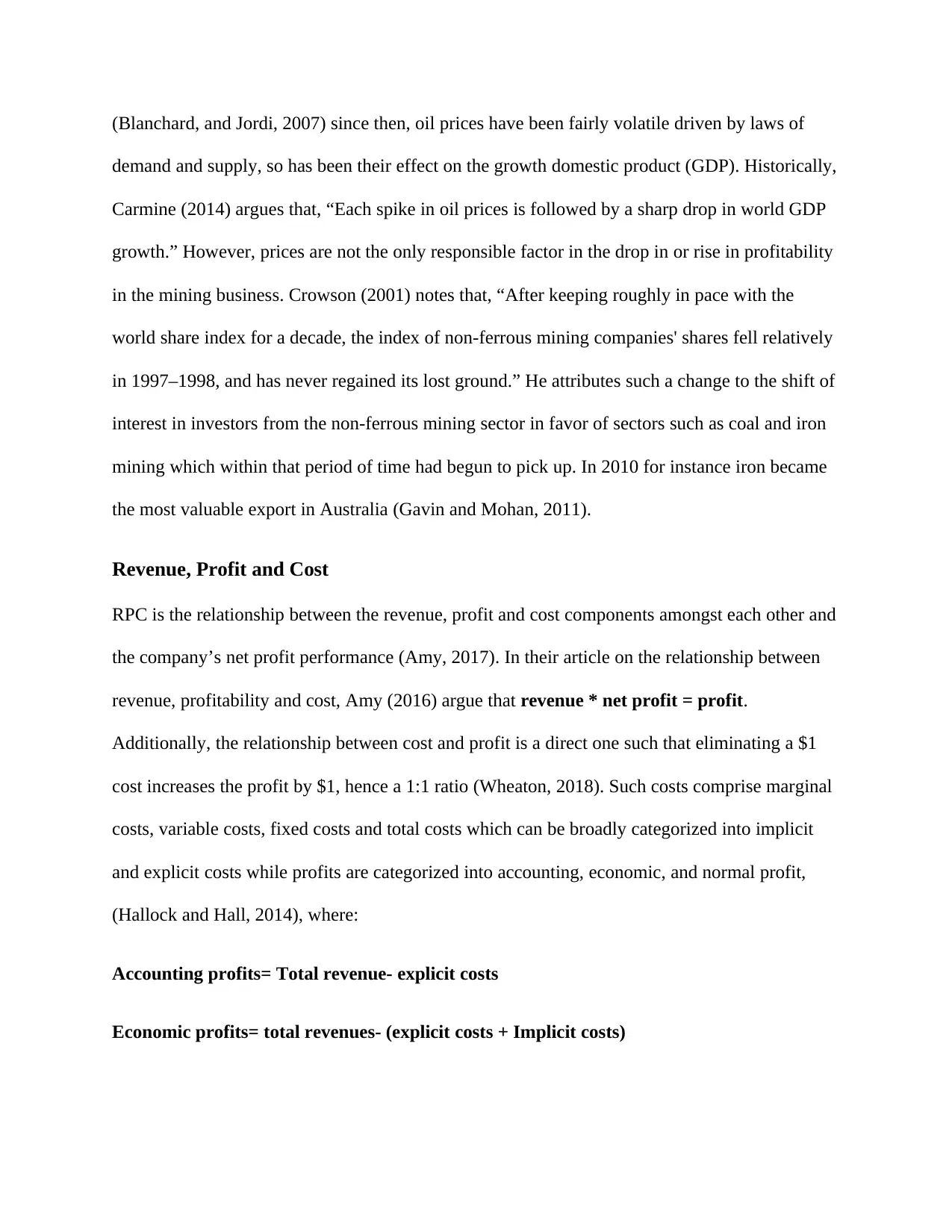
(Blanchard, and Jordi, 2007) since then, oil prices have been fairly volatile driven by laws of
demand and supply, so has been their effect on the growth domestic product (GDP). Historically,
Carmine (2014) argues that, “Each spike in oil prices is followed by a sharp drop in world GDP
growth.” However, prices are not the only responsible factor in the drop in or rise in profitability
in the mining business. Crowson (2001) notes that, “After keeping roughly in pace with the
world share index for a decade, the index of non-ferrous mining companies' shares fell relatively
in 1997–1998, and has never regained its lost ground.” He attributes such a change to the shift of
interest in investors from the non-ferrous mining sector in favor of sectors such as coal and iron
mining which within that period of time had begun to pick up. In 2010 for instance iron became
the most valuable export in Australia (Gavin and Mohan, 2011).
Revenue, Profit and Cost
RPC is the relationship between the revenue, profit and cost components amongst each other and
the company’s net profit performance (Amy, 2017). In their article on the relationship between
revenue, profitability and cost, Amy (2016) argue that revenue * net profit = profit.
Additionally, the relationship between cost and profit is a direct one such that eliminating a $1
cost increases the profit by $1, hence a 1:1 ratio (Wheaton, 2018). Such costs comprise marginal
costs, variable costs, fixed costs and total costs which can be broadly categorized into implicit
and explicit costs while profits are categorized into accounting, economic, and normal profit,
(Hallock and Hall, 2014), where:
Accounting profits= Total revenue- explicit costs
Economic profits= total revenues- (explicit costs + Implicit costs)
demand and supply, so has been their effect on the growth domestic product (GDP). Historically,
Carmine (2014) argues that, “Each spike in oil prices is followed by a sharp drop in world GDP
growth.” However, prices are not the only responsible factor in the drop in or rise in profitability
in the mining business. Crowson (2001) notes that, “After keeping roughly in pace with the
world share index for a decade, the index of non-ferrous mining companies' shares fell relatively
in 1997–1998, and has never regained its lost ground.” He attributes such a change to the shift of
interest in investors from the non-ferrous mining sector in favor of sectors such as coal and iron
mining which within that period of time had begun to pick up. In 2010 for instance iron became
the most valuable export in Australia (Gavin and Mohan, 2011).
Revenue, Profit and Cost
RPC is the relationship between the revenue, profit and cost components amongst each other and
the company’s net profit performance (Amy, 2017). In their article on the relationship between
revenue, profitability and cost, Amy (2016) argue that revenue * net profit = profit.
Additionally, the relationship between cost and profit is a direct one such that eliminating a $1
cost increases the profit by $1, hence a 1:1 ratio (Wheaton, 2018). Such costs comprise marginal
costs, variable costs, fixed costs and total costs which can be broadly categorized into implicit
and explicit costs while profits are categorized into accounting, economic, and normal profit,
(Hallock and Hall, 2014), where:
Accounting profits= Total revenue- explicit costs
Economic profits= total revenues- (explicit costs + Implicit costs)
⊘ This is a preview!⊘
Do you want full access?
Subscribe today to unlock all pages.

Trusted by 1+ million students worldwide
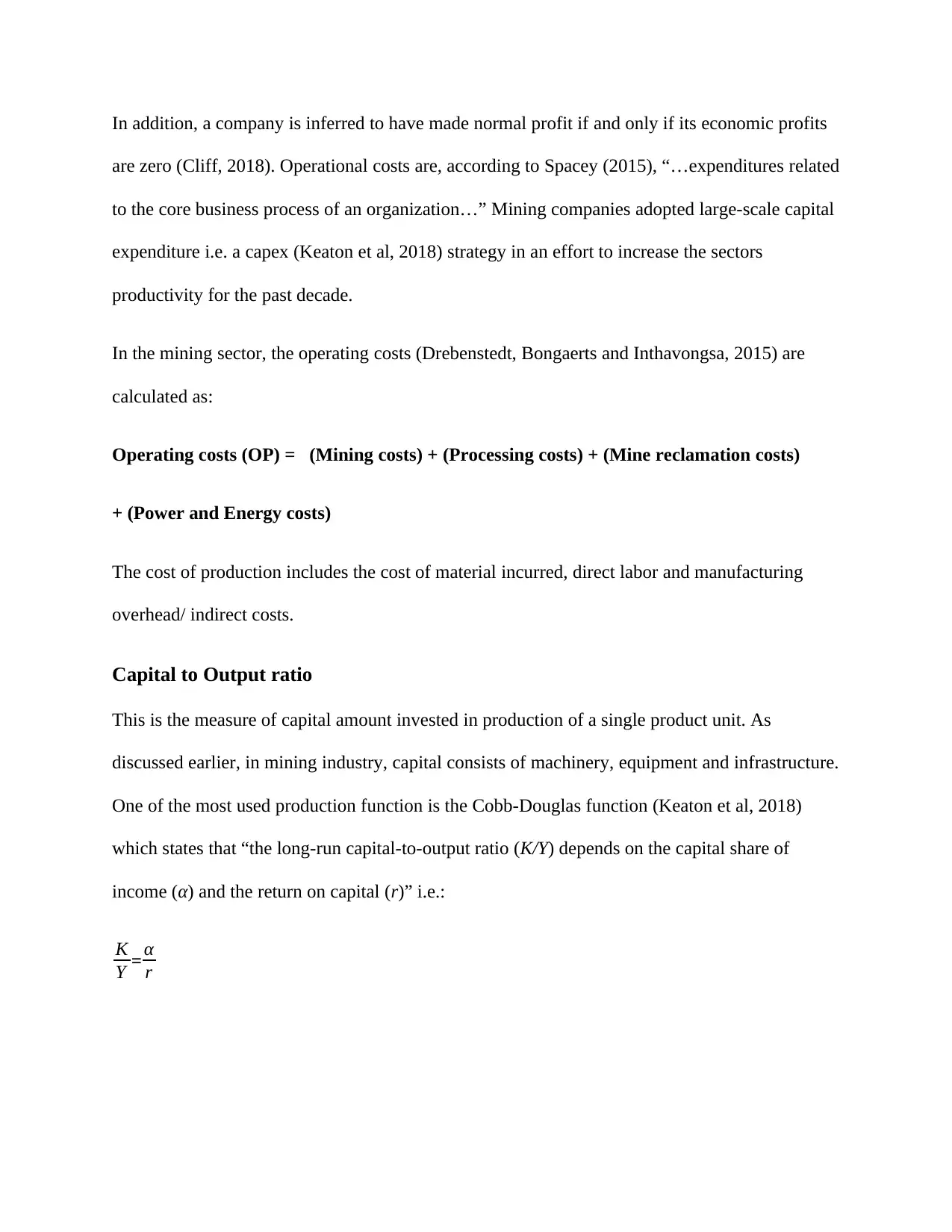
In addition, a company is inferred to have made normal profit if and only if its economic profits
are zero (Cliff, 2018). Operational costs are, according to Spacey (2015), “…expenditures related
to the core business process of an organization…” Mining companies adopted large-scale capital
expenditure i.e. a capex (Keaton et al, 2018) strategy in an effort to increase the sectors
productivity for the past decade.
In the mining sector, the operating costs (Drebenstedt, Bongaerts and Inthavongsa, 2015) are
calculated as:
Operating costs (OP) = (Mining costs) + (Processing costs) + (Mine reclamation costs)
+ (Power and Energy costs)
The cost of production includes the cost of material incurred, direct labor and manufacturing
overhead/ indirect costs.
Capital to Output ratio
This is the measure of capital amount invested in production of a single product unit. As
discussed earlier, in mining industry, capital consists of machinery, equipment and infrastructure.
One of the most used production function is the Cobb-Douglas function (Keaton et al, 2018)
which states that “the long-run capital-to-output ratio (K/Y) depends on the capital share of
income (α) and the return on capital (r)” i.e.:
K
Y = α
r
are zero (Cliff, 2018). Operational costs are, according to Spacey (2015), “…expenditures related
to the core business process of an organization…” Mining companies adopted large-scale capital
expenditure i.e. a capex (Keaton et al, 2018) strategy in an effort to increase the sectors
productivity for the past decade.
In the mining sector, the operating costs (Drebenstedt, Bongaerts and Inthavongsa, 2015) are
calculated as:
Operating costs (OP) = (Mining costs) + (Processing costs) + (Mine reclamation costs)
+ (Power and Energy costs)
The cost of production includes the cost of material incurred, direct labor and manufacturing
overhead/ indirect costs.
Capital to Output ratio
This is the measure of capital amount invested in production of a single product unit. As
discussed earlier, in mining industry, capital consists of machinery, equipment and infrastructure.
One of the most used production function is the Cobb-Douglas function (Keaton et al, 2018)
which states that “the long-run capital-to-output ratio (K/Y) depends on the capital share of
income (α) and the return on capital (r)” i.e.:
K
Y = α
r
Paraphrase This Document
Need a fresh take? Get an instant paraphrase of this document with our AI Paraphraser
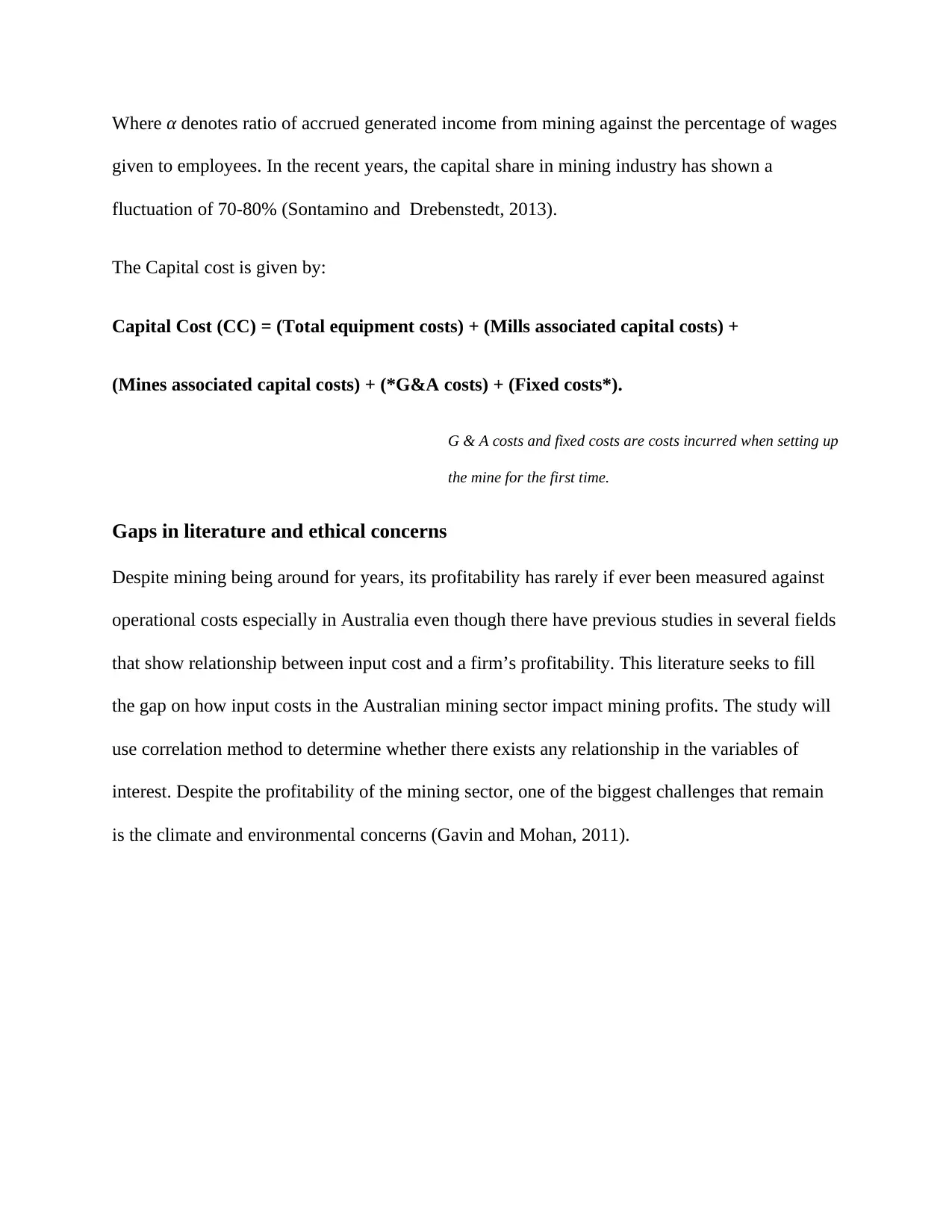
Where α denotes ratio of accrued generated income from mining against the percentage of wages
given to employees. In the recent years, the capital share in mining industry has shown a
fluctuation of 70-80% (Sontamino and Drebenstedt, 2013).
The Capital cost is given by:
Capital Cost (CC) = (Total equipment costs) + (Mills associated capital costs) +
(Mines associated capital costs) + (*G&A costs) + (Fixed costs*).
G & A costs and fixed costs are costs incurred when setting up
the mine for the first time.
Gaps in literature and ethical concerns
Despite mining being around for years, its profitability has rarely if ever been measured against
operational costs especially in Australia even though there have previous studies in several fields
that show relationship between input cost and a firm’s profitability. This literature seeks to fill
the gap on how input costs in the Australian mining sector impact mining profits. The study will
use correlation method to determine whether there exists any relationship in the variables of
interest. Despite the profitability of the mining sector, one of the biggest challenges that remain
is the climate and environmental concerns (Gavin and Mohan, 2011).
given to employees. In the recent years, the capital share in mining industry has shown a
fluctuation of 70-80% (Sontamino and Drebenstedt, 2013).
The Capital cost is given by:
Capital Cost (CC) = (Total equipment costs) + (Mills associated capital costs) +
(Mines associated capital costs) + (*G&A costs) + (Fixed costs*).
G & A costs and fixed costs are costs incurred when setting up
the mine for the first time.
Gaps in literature and ethical concerns
Despite mining being around for years, its profitability has rarely if ever been measured against
operational costs especially in Australia even though there have previous studies in several fields
that show relationship between input cost and a firm’s profitability. This literature seeks to fill
the gap on how input costs in the Australian mining sector impact mining profits. The study will
use correlation method to determine whether there exists any relationship in the variables of
interest. Despite the profitability of the mining sector, one of the biggest challenges that remain
is the climate and environmental concerns (Gavin and Mohan, 2011).
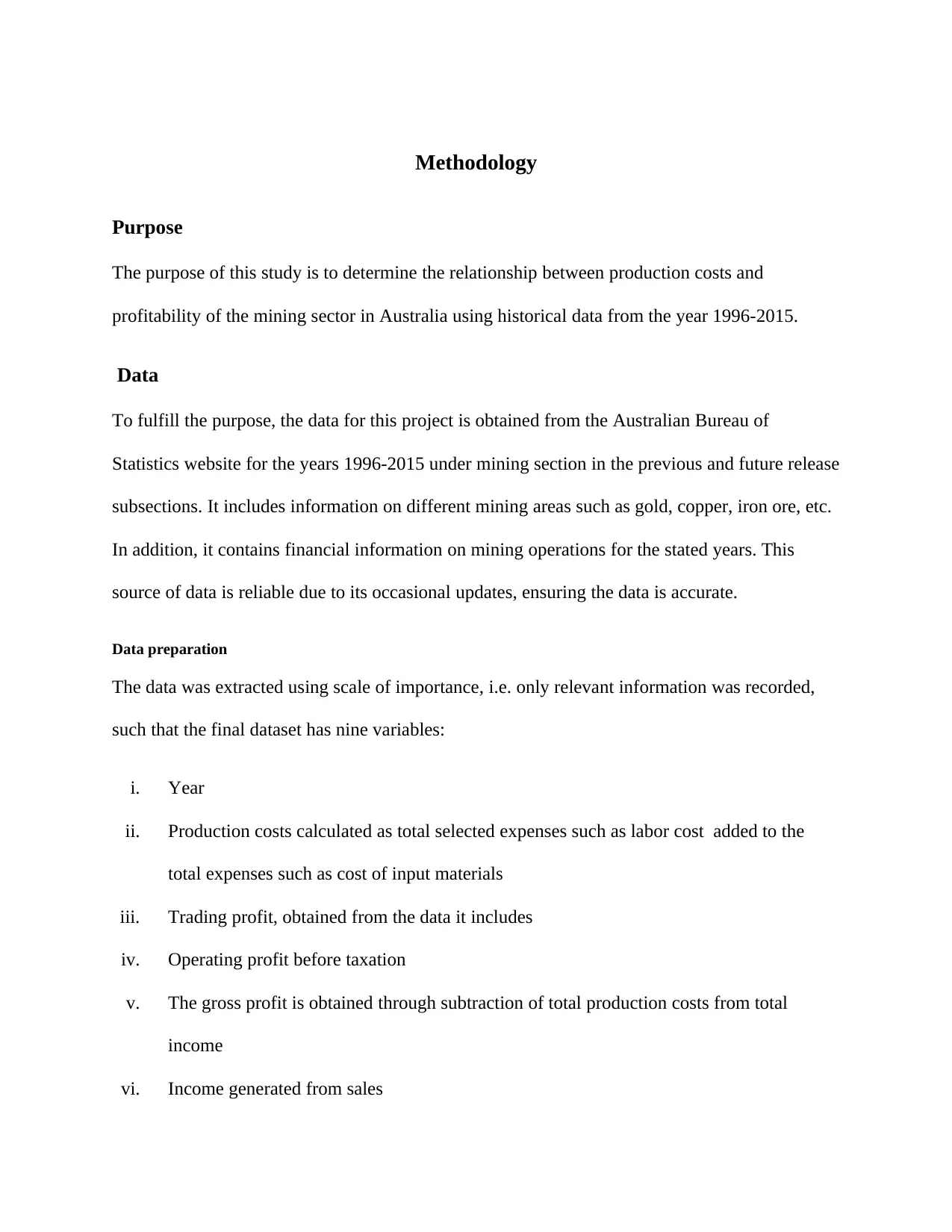
Methodology
Purpose
The purpose of this study is to determine the relationship between production costs and
profitability of the mining sector in Australia using historical data from the year 1996-2015.
Data
To fulfill the purpose, the data for this project is obtained from the Australian Bureau of
Statistics website for the years 1996-2015 under mining section in the previous and future release
subsections. It includes information on different mining areas such as gold, copper, iron ore, etc.
In addition, it contains financial information on mining operations for the stated years. This
source of data is reliable due to its occasional updates, ensuring the data is accurate.
Data preparation
The data was extracted using scale of importance, i.e. only relevant information was recorded,
such that the final dataset has nine variables:
i. Year
ii. Production costs calculated as total selected expenses such as labor cost added to the
total expenses such as cost of input materials
iii. Trading profit, obtained from the data it includes
iv. Operating profit before taxation
v. The gross profit is obtained through subtraction of total production costs from total
income
vi. Income generated from sales
Purpose
The purpose of this study is to determine the relationship between production costs and
profitability of the mining sector in Australia using historical data from the year 1996-2015.
Data
To fulfill the purpose, the data for this project is obtained from the Australian Bureau of
Statistics website for the years 1996-2015 under mining section in the previous and future release
subsections. It includes information on different mining areas such as gold, copper, iron ore, etc.
In addition, it contains financial information on mining operations for the stated years. This
source of data is reliable due to its occasional updates, ensuring the data is accurate.
Data preparation
The data was extracted using scale of importance, i.e. only relevant information was recorded,
such that the final dataset has nine variables:
i. Year
ii. Production costs calculated as total selected expenses such as labor cost added to the
total expenses such as cost of input materials
iii. Trading profit, obtained from the data it includes
iv. Operating profit before taxation
v. The gross profit is obtained through subtraction of total production costs from total
income
vi. Income generated from sales
⊘ This is a preview!⊘
Do you want full access?
Subscribe today to unlock all pages.

Trusted by 1+ million students worldwide
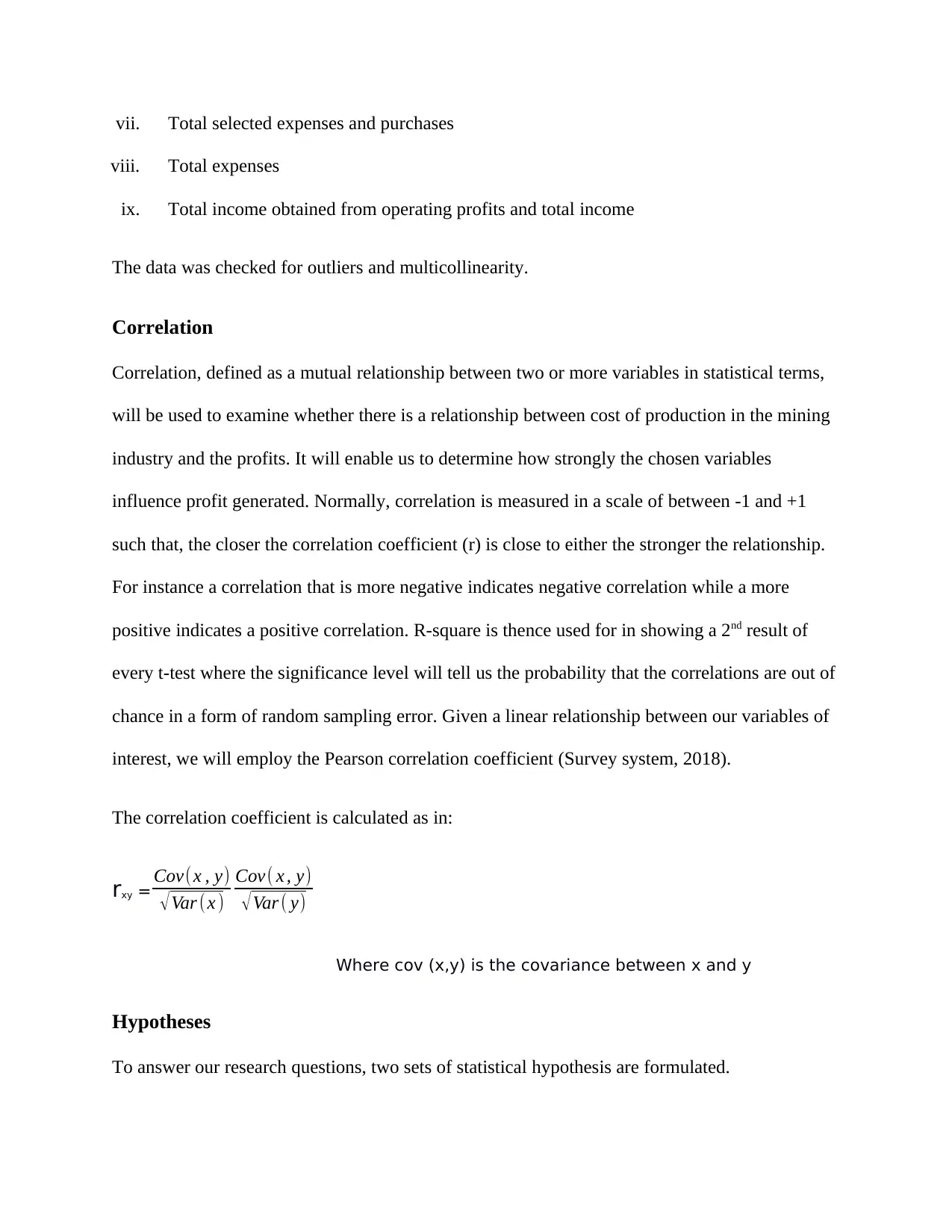
vii. Total selected expenses and purchases
viii. Total expenses
ix. Total income obtained from operating profits and total income
The data was checked for outliers and multicollinearity.
Correlation
Correlation, defined as a mutual relationship between two or more variables in statistical terms,
will be used to examine whether there is a relationship between cost of production in the mining
industry and the profits. It will enable us to determine how strongly the chosen variables
influence profit generated. Normally, correlation is measured in a scale of between -1 and +1
such that, the closer the correlation coefficient (r) is close to either the stronger the relationship.
For instance a correlation that is more negative indicates negative correlation while a more
positive indicates a positive correlation. R-square is thence used for in showing a 2nd result of
every t-test where the significance level will tell us the probability that the correlations are out of
chance in a form of random sampling error. Given a linear relationship between our variables of
interest, we will employ the Pearson correlation coefficient (Survey system, 2018).
The correlation coefficient is calculated as in:
rxy = Cov(x , y)
√ Var (x )
Cov( x , y)
√ Var ( y)
Where cov (x,y) is the covariance between x and y
Hypotheses
To answer our research questions, two sets of statistical hypothesis are formulated.
viii. Total expenses
ix. Total income obtained from operating profits and total income
The data was checked for outliers and multicollinearity.
Correlation
Correlation, defined as a mutual relationship between two or more variables in statistical terms,
will be used to examine whether there is a relationship between cost of production in the mining
industry and the profits. It will enable us to determine how strongly the chosen variables
influence profit generated. Normally, correlation is measured in a scale of between -1 and +1
such that, the closer the correlation coefficient (r) is close to either the stronger the relationship.
For instance a correlation that is more negative indicates negative correlation while a more
positive indicates a positive correlation. R-square is thence used for in showing a 2nd result of
every t-test where the significance level will tell us the probability that the correlations are out of
chance in a form of random sampling error. Given a linear relationship between our variables of
interest, we will employ the Pearson correlation coefficient (Survey system, 2018).
The correlation coefficient is calculated as in:
rxy = Cov(x , y)
√ Var (x )
Cov( x , y)
√ Var ( y)
Where cov (x,y) is the covariance between x and y
Hypotheses
To answer our research questions, two sets of statistical hypothesis are formulated.
Paraphrase This Document
Need a fresh take? Get an instant paraphrase of this document with our AI Paraphraser
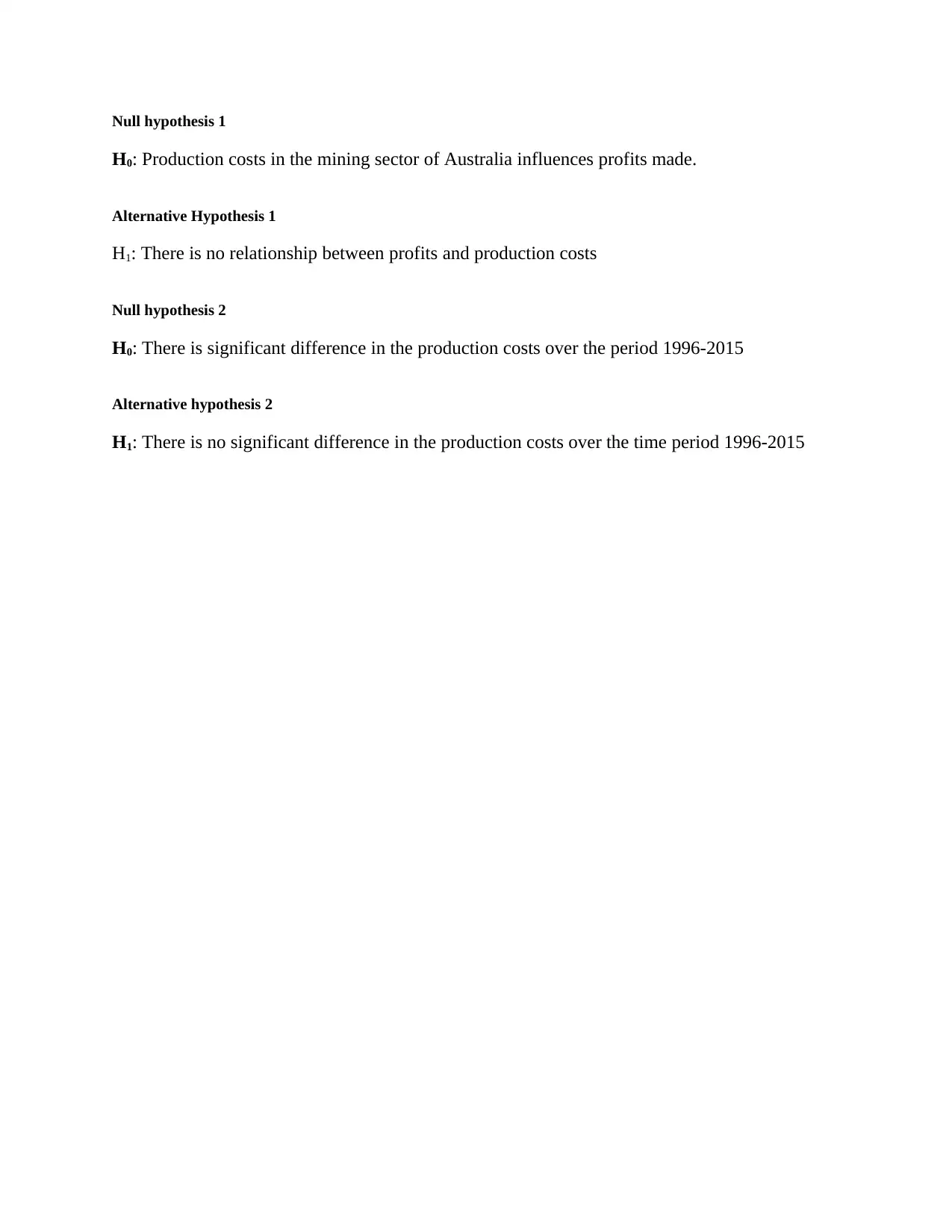
Null hypothesis 1
H0: Production costs in the mining sector of Australia influences profits made.
Alternative Hypothesis 1
H1: There is no relationship between profits and production costs
Null hypothesis 2
H0: There is significant difference in the production costs over the period 1996-2015
Alternative hypothesis 2
H1: There is no significant difference in the production costs over the time period 1996-2015
H0: Production costs in the mining sector of Australia influences profits made.
Alternative Hypothesis 1
H1: There is no relationship between profits and production costs
Null hypothesis 2
H0: There is significant difference in the production costs over the period 1996-2015
Alternative hypothesis 2
H1: There is no significant difference in the production costs over the time period 1996-2015

Findings
In this section, we present the results of our statistical analyses and hypothesis section for
discussion in the next section.
Descriptive statistics
Figure 1
From figure 1, the minimum selected expenses which include expenses such as indirect inputs in
production I.e. fuel etc for the time period 1996-2007 and 2011-2015 is $12, 380 million while
the maximum is $40, 260 million with a mean expense of $27, 332.21 million. The average cost
of production is $101, 284.72 million and the average profit for the time period is $69, 463.32
million.
In this section, we present the results of our statistical analyses and hypothesis section for
discussion in the next section.
Descriptive statistics
Figure 1
From figure 1, the minimum selected expenses which include expenses such as indirect inputs in
production I.e. fuel etc for the time period 1996-2007 and 2011-2015 is $12, 380 million while
the maximum is $40, 260 million with a mean expense of $27, 332.21 million. The average cost
of production is $101, 284.72 million and the average profit for the time period is $69, 463.32
million.
⊘ This is a preview!⊘
Do you want full access?
Subscribe today to unlock all pages.

Trusted by 1+ million students worldwide
1 out of 28
Related Documents
Your All-in-One AI-Powered Toolkit for Academic Success.
+13062052269
info@desklib.com
Available 24*7 on WhatsApp / Email
![[object Object]](/_next/static/media/star-bottom.7253800d.svg)
Unlock your academic potential
Copyright © 2020–2025 A2Z Services. All Rights Reserved. Developed and managed by ZUCOL.





